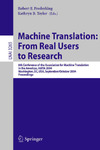Please use this identifier to cite or link to this item:
http://lib.hpu.edu.vn/handle/123456789/32786Full metadata record
| DC Field | Value | Language |
|---|---|---|
| dc.contributor.author | Allen, Jeffrey | en_US |
| dc.contributor.editor | Frederking, Robert E. | en_US |
| dc.contributor.editor | Taylor, Kathryn B. | en_US |
| dc.date.accessioned | 2019-05-28T04:17:05Z | - |
| dc.date.available | 2019-05-28T04:17:05Z | - |
| dc.date.issued | 2004 | en_US |
| dc.identifier.isbn | 3540233008 | en_US |
| dc.identifier.isbn | 9783540233008 | en_US |
| dc.identifier.isbn | 9783540301943 | en_US |
| dc.identifier.other | HPU1161348 | en_US |
| dc.identifier.uri | https://lib.hpu.edu.vn/handle/123456789/32786 | - |
| dc.description.abstract | The previous conference in this series (AMTA 2002) took up the theme “From Research to Real Users”, and sought to explore why recent research on data-driven machine translation didn’t seem to be moving to the marketplace. As it turned out, the ?rst commercial products of the data-driven research movement were just over the horizon, and in the intervening two years they have begun to appear in the market place. At the same time,rule-based machine translation systems are introducing data-driven techniques into the mix in their products. Machine translation as a software application has a 50-year history. There are an increasing number of exciting deployments of MT, many of which will be exhibited and discussed at the conference. But the scale of commercial use has never approached the estimates of the latent demand. In light of this, we reversed the question from AMTA 2002, to look at the next step in the path to commercial success for MT. We took user needs as our theme, and explored how or whether market requirements are feeding into research programs. The transition of research discoveries to practical use involves technical questions that are not assexy as those that have driven there search community and research funding. Important product issues such as system customizability, computing resource requirements, and usability and ?tness for particular tasks need to engage the creative energie so fall part so four community, especially research,aswe move machine translation from a niche application to a more pervasive language conversion process. These topics were addressed at the conference through the papers contained in the sep-ceedings, and even more specíically through several invited presentations and panels. | en_US |
| dc.format.extent | 297 p. | en_US |
| dc.format.mimetype | application/pdf | |
| dc.language.iso | en | en_US |
| dc.publisher | Springer-Verlag Berlin Heidelberg | en_US |
| dc.subject | Artificial Intelligence | en_US |
| dc.subject | Mathematical Logic and Formal Languages | en_US |
| dc.subject | Document Preparation and Text Processing | en_US |
| dc.subject | Language Translation and Linguistics | en_US |
| dc.title | Machine Translation: From Real Users to Research: 6th Conference of the Association for Machine Translation in the Americas, AMTA 2004, Washington, DC, USA, September 28 - October 2, 2004. Proceedings | en_US |
| dc.type | Book | en_US |
| dc.size | 6,313 KB | en_US |
| dc.department | Technology | en_US |
| Appears in Collections: | Technology | |
Files in This Item:
| File | Description | Size | Format | |
|---|---|---|---|---|
| Machine-Translation-From-Real-Users-to-Research-1373.pdf Restricted Access | 6.31 MB | Adobe PDF |  View/Open Request a copy |
Items in DSpace are protected by copyright, with all rights reserved, unless otherwise indicated.
